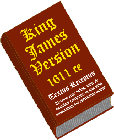

King James Only
Movement

As recently as 1960, the vast majority of families in America had a King James Version
(KJV) of the Bible somewhere in their homes. And only a small percentage had any
other translation, such as the 1922 Moffatt New Translation (MNT), the 1901 American
Standard Version (ASV) or the 1951 update of the ASV, the Revised Standard Version
(RSV). Only "serious" Bible students had multiple translations, and even they usually
used the KJV as their "primary" Bible for both general reading and in-
All of this began to change in the 1960s, and later in particular in the 1970s, as
a number of fresh "modern English" translations such as the Amplified Bible (AMP),
the New International Version (NIV), and the New American Standard Bible (NASB) came
on the market. Contemporary writers of inspirational and Bible Study materials for
both youth and adults began to quote these more modern translations in their books
and articles, realizing that the archaic 1611 AD language of the KJV was, in many
cases, almost incomprehensible to modern readers without extensive "translation"
itself! By the year 2000, the NIV was emerging as the leader in Bible sales and was
the most-
Alongside these new translations, however, there arose a "movement" which began to condemn such innovations. Articles, books, and tapes by teachers involved with this movement, dubbed the King James Only (KJVO) movement by both adherents and critics, gained only limited publicity to their cause until 1993. In that year, a book hit the mass market in America:
New Age Bible Versions:
An Exhaustive Documentation Exposing the Message, Men and Manuscripts
Moving Mankind
to the Antichrist's One World Religion.
"The New Case against the NIV, NASB, NKJV,
NRSV, NAB,
REB, RSV, CEV, TEV, GNB, Living, Phillips, New Jerusalem, & New Century."
The author was a woman named Gail Riplinger. The book, the author, and later her
video version of the same material gained wide-
For the past decade and more, this movement has gained such a following that many phone books for cities and towns throughout the country include ads for "King James 1611 Only" congregations in the Church section of the Yellow Pages. A Google search on "KJV Only" yields over 300,000 websites which report about, promote, discuss, or question this movement's stance.

The Claims
Excerpts from public relations material for Riplinger's book and related video, shown
below, make clear the most radical elements of the basics of the belief of hard-
"The 700-
"The emerging "new" Christianity — with its substitution of riches for righteousness, a crown for a cross, and an imitation for a new creation — is shown to be a direct result of the wording in new versions. Each page opens a door exposing new version editors — in agreement with Luciferians, occultists, and New Age philosophy — in mental institutions, seance parlors, prison cells, and court rooms for heresy trials — and most shocking of all — denying that salvation is through faith in Jesus Christ. Five have lost their ability to speak.
"The Greek manuscripts, critical editions, lexicons, and dictionaries behind
the new versions are examined, revealing their occult origins, contents, and yet
unreleased material — a blueprint for the antichrist’s one-
Underneath this hysterical hype are several basic claims of the KJVO movement:
- The King James Version of the Bible is not viewed as just the "best" Bible translation
available in English-
- only legitimate translation. As a slogan on one KJVO site puts it, "If it ain't the King James, it ain't the Bible."it is viewed as the - The KJV is not viewed as just an admirable, scholarly, human effort at translation-
- word for word, are viewed as "inerrant"-it is viewed as having been directly, divinely inspired. Some KJVO advocates go so far as to claim that the translators were inspired in their work in exactly the same way as the original Bible authors, and thus their words, - without any flaws. - The translators of modern versions are not viewed as just being inferior scholars to the KJV translators. They are viewed as either being men and women confused or duped by the Devil himself into doing his nefarious work of watering down the Truth through poor or utterly incorrect translation; or as corrupt people with personal agendas which they have inserted into their work by erroneous translation of certain words and passages.
- The Greek and Hebrew manuscripts which the King James translators used in preparation of the KJV are also viewed as being the only perfect manuscripts. When later historical evidence has shown that some words and phrases in those manuscripts were doubtless not in the earliest manuscript copies, such historic evidence is declared by KJVO advocates to be erroneous no matter how solid … for it is, in their view, impossible for the KJV translators to have used flawed manuscripts.
- When analyzing the content of a Bible translation, the KJVO advocate will not choose
to compare the translation to Hebrew and Greek manuscripts, but rather to the KJV
as the "standard" to decide its validity. Since all modern translations, from the
100-
year- old RSV to the recent New King James Version (NKJV) vary from the KJV, they are all viewed as being inferior at best- - and part of a satanic conspiracy to water down and change the scriptures at worst. - Earlier KJVO adherents primarily emphasized their view of the superiority of the KJV. But, since the advent of Riplinger's book and its many imitators, it appears that the majority of those who identify themselves as KJVO believers have adopted the "satanic conspiracy" theory. This postulates that there has been a concerted effort since the 1800s to corrupt the content of the Bible through erroneous translations in order to effect doctrinal changes leading ultimately to a corrupt "New Age" religion that will seduce Christians to worship the ultimate Antichrist.
- King James of England, the man who commissioned the work of the King James Version translators, is viewed as being a paragon of virtue with totally pure motives to further the Christian faith.
![]()
The Allure
As with many such esoteric movements, the aura of being "one of the elite" who understand
secrets not known by "the rabble" seems to appeal to many adopting the KJVO position.
And many of the writings of the movement, particularly Riplinger's huge book, seem
to be, to the non-
At the same time, Riplinger and the other primary promoters of the movement are extremely
dogmatic and bombastic in their claims. Thus those who are uncomfortable with any
element of doubt in their faith system find such extreme confidence a boost to their
own confidence in what they believe. Many Christians are puzzled at the notion that
we don't really have the "original manuscripts" for the Bible-

Concerns
Riplinger and other KJVO advocates attempt to substantiate such claims as those listed above using what is advertised as careful scholarship and research and compelling logic. But close examination of many of their materials reveals extremely serious flaws in the scholarship, research, and logic which render the claims of such writers shaky at best and ludicrous at worst.
- Much of the attraction of many readers to the writings of popular KJVO authors such as Riplinger is based not on the authors' use of sound logic and careful explanation of facts in their writings, but on the frantic (almost hysterical at times) "hype" of their claims. They particularly play on the emotions of those who know nothing about how the Bible was transmitted and translated from the first century to the present. In addition, many of the authors of KJVO material, including Riplinger and Peter Ruckman in particular, resort much of the time to not just emotional appeals … but highly inflammatory, bombastic, hateful, sneering rhetoric.
- A significant number of the alleged "historical facts" presented by these authors can be shown to be erroneous.
- A significant number of the allegations against modern translators can be shown to be distorted, misrepresented, or outright lies. And the alleged purity of character and purity of purpose of King James himself promoted by KJVO writers can be shown to be a gross distortion of historical reality.
- The "logic" of many of the accusations against the modern translations can be shown to be often poor at best and downright silly at worst.
- Much of the "scholarship" used to explain the relevant factors of the methods of
translation can be shown to be slip-
shod or deceptive at best, and totally un- scholarly at worst. - The objectivity of the KJV translators can be shown to be compromised by both the details of their commission from King James and by their own limited world view in the times in which they lived. This is not a criticism of their individual integrity, but merely a reality which precludes them from being somehow "holier" than any other translators in history, and precludes their translation from being totally objective.
- The insistence that everyone, including children and teens and new Christians, must get their only exposure to the truths of the Bible from listening to and reading the King James Version effectively cripples the ability of many to comprehend the Gospel. While there are, indeed, a few minor points of doctrine that may be affected by the choice between one translation or another, the basics of Salvation are very clear in any of the standard modern translations such as the NIV, NASB, or NKJV. And the basics of guidance on Christian daily living are identical in all these also. The Golden Rule, the Ten Commandments, the Sermon on the Mount, the Love Chapter (I Corinthians 13) all convey essentially the same meaning in all of the modern translations, and do not "teach something different" from what the KJV teaches.

Examination
It is not the purpose of this profile
to minimize the value of the King James Version
of the Bible.
Nor is it the purpose of this profile
to promote any or all other translations as
having equal value to the Christian.
The purpose is to call into question and evaluate
the specific claims of the KJVO
movement as outlined above.
Please note that the movement itself is not "monolithic," and that some individuals and groups which may choose to label themselves as proponents of "King James Onlyism" may not agree with every single point of the claims listed in this profile. But a perusal of the materials promoted by a wide variety of such groups will indicate that the claims listed here are common to many of them. Thus this profile is not addressed to any specific group of teachers or ministries, but to the specific claims which they may make. If a group does not advocate one of these claims, then the evaluation in this profile of that specific claim does not apply to that group.
Some valid reasons to prefer the King James Version for some purposes
No matter whether someone believes the KJV to be the best translation or not, almost
all English-
- Many classic "Bible helps" materials are keyed to the wording of the KJV. This is particularly true of the classic concordances, Strong's Exhaustive Concordance with Greek and Hebrew Lexicons, and Young's Analytical Concordance. Thus one needs to use the KJV in order to use these volumes and many others like them.
- An individual who first does extensive study in the Bible over a period of years
using the KJV may well have many passages committed to memory in the language of
that version … even though he or she may later find that the meaning of a particular
passage is much clearer in a modern translation. If such a person is trying to remember
where to find this passage in the Bible, they may well need to bring it to mind in
the KJV wording and then look it up in Strong's or another KJV concordance. Then
they can cross-
reference it to the modern translations they wish to consult. - There is no question that the "literary quality" of the KJV is eloquent, in the same
way the works of Shakespeare (from the same period in history) are considered eloquent.
Many words and phrases have worked their way into our vocabulary from the KJV, such
as "apple of my eye." Thus in order to be "culturally literate" it is important to
be familiar with the text of the KJV. This doesn't mean that one needs to consider
it "clear" all the time … trying to read a Shakespearean play without a foot-
noted edition can leave the average 21st century reader totally baffled much of the time. In the same way, one can "admire" the majestic turns of phrase in the book of Isaiah in the KJV, for instance … but it may be helpful to have a commentary or a modern translation nearby in order to get the full import of the words.
Historical background of "modern translations"
If you are over 40 years old and speak English as your native language, the first Bible you ever heard read from as a child was likely a KJV. And the first Bible you owned was likely a KJV. As noted in the introduction to this profile, as recently as 1960, virtually every family in America that had a Bible in the household had a King James Version Bible. And almost every motel and hotel room in America had a KJV. And almost every church that had a "pulpit Bible" displayed at the front of the church chose a KJV for that purpose. And most ministers, evangelists, and Bible teachers would quote from the KJV in their speaking and writing.
A minority of those homes with a KJV might also have one or more "modern translation" Bibles on their bookshelf, but they would have had few of those from which to choose. And only a "serious Bible student" in the home would be likely to get such a translation down from the shelf, in order to do a comparison with the KJV for some special project.
Forty years ago, the only Bible version which might be considered by the average person as an acceptable alternative to the KJV as a "first choice" for a family Bible would have been the Revised Standard Version. But this was not really, in the strictest sense of the word, a new "translation." It was merely, as the title indicates, a "revision" of earlier Bibles. The KJV had first been published in 1611, and had been reprinted for the next 250 years with only relatively few minor changes in spelling and such in subsequent editions.
A British revision of the KJV, titled the English Revised Version, was published in 1885. It attempted to retain most of the text of the KJV but take into account some of the manuscript discoveries and findings in Greek and Hebrew scholarship that had occurred in the time since the KJV had been first published. The team creating this version also included American scholars.
A related American edition, the American Revised Version (ARV), was published in 1901 that reflected some of the preferences of the American members of the translation committee that had not been adopted by the British edition of the English Revised Version. A further revision of this American revision, the Revised Standard Version (RSV), was published in 1952. Although gaining a moderate acceptance in some circles as an alternative to the KJV for use in churches and homes, the RSV never really put a dent in KJV Bible sales.
A number of other modern translations were also made after the ARV of 1901, such as the Moffatt New Translation of 1922. But these appealed primarily to serious Bible students and teachers who wanted to delve deeply into specific areas of Bible study, not to the general public.
Yes, almost every American family prior to 1970 or so that had a Bible in the home
had a KJV, even if they had one or more other translations. This was not necessarily
because the family members "preferred" to read the KJV version-
At least this was true until the 1970s. Since that time, more and more people have chosen to purchase a more modern translation of the Bible for their first choice for their own use for personal Bible study or as a family Bible. And this seemed an innocent choice … until the King James Only movement began. For the details on the rise of this movement, see the section later in this profile titled Apparent Roots of the KJVO Movement.
Greek Texts
One of the consistent accusations of the KJVO proponents doesn't have to do with just the translators of the modern versions, but with one of the sources of the underlying Greek text which many such translators have used in preparing the translation of the New Testament (NT).
Any translation of the NT must begin with deciding which ancient copies of the Greek manuscripts of the NT writings to accept as most reliable. The original manuscripts straight from the pens of the authors are obviously no longer available. We must make do with copies of copies of copies. Thankfully, the first century Christians made many copies of the writings of the Apostles and other NT authors and spread them throughout the Roman Empire. And each generation thereafter continued making copies and spreading them widely.
However, as this was done, errors crept into the copied versions. Copyists would
sometimes accidentally leave out a word or phrase, or perhaps even a whole verse.
At other times, one might-
Because we have such a large number of ancient copies to compare, in most instances it is quite easy to spot such problems and determine what was in the original, and what were later additions. But not in all instances. And therein lies the "textual" problem. Translations are only as accurate as the Greek manuscripts or the "compiled Greek text" that they are working from. Someone or some group of people must make the ultimate decision on what to include in the material to be used for the purposes of translation.
At the time of the translation of the KJV, there were few choices to be made, for the collection of ancient manuscripts available for consultation was very limited. Thus the KJV translators used, primarily, as their underlying Greek text a compiled document in Greek known as the Received Text (Textus Receptus in Latin.) This had been compiled long before by other scholars. (It is not the purpose of this profile to go into all of the technical issues and detailed history in the transmission and translation of the ancient texts. For details on these matters, consult some of the links in the Bibliography below.)
But by the late 1800s, many more ancient manuscript copies were available for inclusion
in the evaluation process. And, in addition, many more ancient extra-
Even more such materials have become available from that time to the present. Thus modern scholars are convinced that they should take advantage of this greater collection of materials when making translation decisions. Proponents of the KJVO movement, however, are adamant that all of this is irrelevant. They seem to suggest that taking any of these matters into consideration would be merely watering down the “Truth once delivered” by the KJV translators. (Even on the face of it, this seems to be a very strange approach to scholarship. For more details on just how KJVO advocates deal with these matters, consult some of the links in the Bibliography below.)
The KJVO proponents particularly call into question the development of a new compiled
Greek NT created in the late 1800s by Anglican scholars Brooke F. Westcott and Fenton
J.A. Hort. Since that time, this document, referred to as the Westcott and Hort Greek
Text (W-
Although there are a number of reasons for the differences between the W-
In general, Westcott and Hort chose to give greater weight to the age of manuscript
copies than to raw numbers of copies. In other words, those copies deemed to be closest
to the time of the original authors of the NT were viewed as more likely to be more
accurate. (Please note that this is a very simplified overview of some of the issues
involved, and is not intended to be a "scholarly" explanation of the matters at hand.
The Bibliography below contains information on where to obtain carefully-
Many of the more recent Bible translations, such as the NIV, do not depend on any
one Greek text such as W-
The Typical KJVO Attack
Here is an example of the kind of allegation that is typical in KJVO material. James White, KJVO critic, addresses the tactics of Gail Riplinger in the following passage from his website (see Bibliography below for info on White):
KJV Only advocates love to fill books with charts of how things have been "removed" from the Bible, all the time alleging that some terrible sinister plot is afoot to hide this doctrine or that. Mrs. Riplinger gives us a great example of this on page 109 of NABV [New Age Bible Versions]:
"The title 'the Virgin' has been applied to the goddesses of the Canaanites (Astarte
and Ashtoreth), the Babylonians (Rhea or Semiramis), the Egyptians (Isis), the Hindus
(Isi, Kanyabava, Trigana), the Romans (mother of Romulus and Remus), and the Greco-
We are then given the following chart:
NIV, NASB et al KJV
OMIT Luke 1:28 blessed art thou among women
Note that Mrs. Riplinger claims that the reason the phrase "blessed art thou among women" is specifically [omitted is] because the new versions are trying to push pagan goddesses upon the Christian Church. Is this the case? Only if the new version editors are really witless! Look at Luke 1:42 as found in the NIV:
In a loud voice she exclaimed: "Blessed are you among women, and blessed is the child you will bear!"
How did THAT get there? Here in all manuscripts, and all modern versions, we find the very phrase in question, "Blessed are you among women." If the modern versions were trying to degrade Mary's unique position, why not delete this reference, too? Because there is no such conspiracy, and because decisions about the text are based upon the evidence provided by the manuscripts, not upon conspiracies. Why would the phrase be inserted at a later date at Luke 1:28? Because of its presence at Luke 1:42. In both situations Mary is being greeted, first by the angel and then by Elizabeth. It seemed natural to a scribe long ago to have the words of Elizabeth come from the mouth of the angel as well.
This kind of misrepresentation of the Biblical text is common place in KJV Only writings. Beware the sleight of hand!
Apparent Roots of the KJVO Movement
The following excerpts are from the article by Baptist author Doug Kutilek at:
http://www.kjvonly.org/doug/kutilek_unlearned_men.htm
Kutilek, former co-
All writers who embrace the KJV-
… Wilkinson's book lay unused and unknown (and how good it would have been had his
errors died with him!), until 1955 when J. J. Ray, who is self-
… The other chief disseminator of Wilkinson's misinformation was David Otis Fuller,
a Regular Baptist pastor. Fuller must be counted as part of the third generation,
since, according to Fuller's own words in the dedication of Counterfeit or Genuine
(1975), Ray's book God Wrote Only One Bible "moved me to begin this fascinating study."
Ray and his book were also repeatedly noted on pp.2-
In 1970, Fuller issued Which Bible?, which was in its 5th edition by 1975 and contained 350 pages. Of those pages, almost half were taken from Wilkinson's Our Authorized Bible Vindicated, with some editing, first to conceal from view Wilkinson's cult affiliation, and second, to correct some of the worst of his errors
… In spite of its inherent defects, inherently contradictory points of view, and
frequent errors, Which Bible? in numerous printings in at least five editions has
had a very extensive influence in shaping much of the current debate and disseminating
much of the misinformation that characterizes KJV-
… Also in the third generation, without question the most vocal and abusive of the KJVO partisans is Peter S. Ruckman …
… All of his writings are characterized by the most vehement vilification and denunciation of everyone and anyone …
And how was Ruckman drawn into the fray? What book influenced him? Ruckman's first-
… Just as Wilkinson misapplied Psalm 12:6,7 to the KJV, as did Ray, so did Ruckman.
Furthermore, in his so-
… Among those heavily influenced by Fuller can be named D. A. Waite, who now does
a great deal of his own misleading, and E. L. Bynum. Jack Chick, whose comic books
have espoused KJV-
… From Wilkinson in the first generation, through Ray in the second, and Fuller and
Ruckman in the third, the entire KJVO movement has arisen, and every present-
… First, the KJV was viewed as better than other English versions, though not above
some revision and correction (thus Ray); then, the view was taken that the KJV was
error-
… Every KJVO advocate is a lineal descendant of Wilkinson, Ray, Fuller and Ruckman,
and all are the victims (unwitting, I hope) of the multitude of gross distortions,
errors, corruptions, misunderstandings, misrepesentations, and, in some cases, out-
(See the link above for the full text of this article.)

Evaluation
Addressing the Concerns listed in this Profile
A single example clarifying each concern listed above is offered here. For many more examples, explore the links in the Bibliography section below.
1. Much of the attraction of many readers to the writings of popular KJVO authors such as Riplinger is based not on the use of sound logic and careful explanation of facts in their writings, but on the frantic (almost hysterical at times) "hype" of their claims. They particularly play on the emotions of those who know nothing about how the Bible was transmitted and translated from the first century to the present. In addition, many of the authors of KJVO material, including Riplinger and Peter Ruckman in particular, resort much of the time to not just emotional appeals… but highly inflammatory, bombastic, hateful, sneering rhetoric.
As an example of appeal to ignorance and emotion, here is an excerpt from a typical introduction to King James Onlyism by a proponent from:
http://www.biblebelievers.com/Branson_KJV1.html
KJV 1611: Perfect!
…You are tired of hearing about old manuscripts, Greek and Hebrew debates, and reading endless explanations of why such and such a word in the "original language" had a "root" the meaning of which is.......or hearing that some word or verse is "unfortunately translated" in the King James as.... And, you really are not interested in Alephs, uncials and codices, whatever they are.
What you really would like to know is if there is a Bible, somewhere, that you can read in your language, that you can trust in every case, and is all between one set of covers.
Here is relief!
In these pages you will find simple, common sense, easy to understand and impossible to refute reasons proving that the King James 1611 is the ONLY Word of God in English; THE Bible that you can read in your language, trust in every word, and have it all between one set of covers. You need examine no manuscript, nor know a single word of Greek or Hebrew, own a Greek lexicon, dictionary nor any other such thing. In fact, you probably are better off by far if you do not.
Oh, how pleasant it would be if no preacher, teacher or professor had such fancied "helps." If we could somehow blank their collective minds of all the Greek they had ever learned, and hide all their Greek and Hebrew texts, lexicons and the like, we would do the faith of Christ better service than one would have done the ladies of London if they could have somehow kept all sharp instruments from the hands of Jack the Ripper.
Forget the Manuscripts and the Original Languages!
You do not need them, and neither does anyone else! Much, much too much is made of
so-
As an example of inflammatory rhetoric, the following is a short excerpt from an exchange of letters between Peter Ruckman (prolific KJVO writer) and James R. White, KJVO critic (see Bibliography below for details on White) which appear on White's Alpha and Omega Ministries website. The full text of this exchange (including actual photos of portions of some of the letters) can be seen at:
http://www.aomin.org/ruckcor.html
If you are familiar with Peter Ruckman and his followers you will hardly be surprised at the tenor of the following materials. If, however, you have not been exposed to his bombastic, acerbic style, you may well be taken back. Terms like "liar," "stupid," "wimp," and terms I personally find to be beyond the pale of clean language, are everyday fare for Dr. Ruckman and his followers. Anything goes in attacking and demeaning those with whom he disagrees (and that's 99.99% of the Christian world). You may at times have to read something twice just to figure out how Dr. Ruckman came up with the ideas that he did. For example, if you conclude that Dr. Ruckman said that Mr. Pierce is a "liar" simply because my book, The King James Only Controversy, was dedicated to Mr. Pierce, you are right. If you are confused about how a man can call someone else a liar without ever having met that person, without ever having read anything that person has written, or heard anything that person has ever said, join the club. That's just how Dr. Ruckman thinks, and acts. Sadly, he has followers who want to emulate his style, and his behavior.
If you are a follower of Peter Ruckman, I could hope that the following information will demonstrate to you that your leader is unwilling and unable to engage in meaningful dialogue and debate. However, most of Dr. Ruckman's followers are blind to his behavior and his illogical reasoning, so the following will probably do little more than confirm your high opinion of Dr. Ruckman.
But if you are a person who has encountered KJV Only materials and are desirous of considering the source and spirit of these materials, the following letters will be of great assistance to you. The issues are addressed in such books as my own or Dr. Carson's The King James Version Debate. The topic of the personal behavior of KJV Only advocates can be gauged, at least with reference to Dr. Ruckman, from his own words.
Here is just one paragraph from one of Ruckman's letters from this webpage, written on letterhead which shows him to be the Pastor of the "Bible Baptist Church." He is also head of the Pensacola Bible Institute. Ruckman writes to White:
…Never mind the pious preaching, sonny. God never called you to preach You have no ability to do it. Stick to destructive criticism. You don't know enough of what the Bible says about Speech to teach a DVBS. Christ called them "foxes," "fools," "serpents" and "vipers." Paul called them "liars," "evil beasts" arid "slow bellies." J. Frank Norris called them "suck egg hounds," and Billy Sunday called them "old bald mutts." If I call them "conceited asses," I am giving them a very mild rebuke. Mordecai Ham called them "hogjowled liquor heads." You know nothing about this kind of thing, so shut your mouth and preach to yourself.
2. A significant number of the complaints against the modern translations can be shown to be irrational and/or baseless.
A number of KJVO authors have actually tried to insist that the KJV is much easier for the average person, including children, to read and understand than the modern translations. Here is a link to an article that quotes some of Riplinger's material on this topic.
http://www.av1611.org/kjv/kjveasy.html
In order to "prove" the case, the text of portions of the KJV, NIV, NASB, and the Today's English Version (TEV) were subjected to a specific "test" which purports to show the grade level at which an individual should be able to easily read the text. The findings reported:
The Flesch-
… Why is the KJV easier to read? The KJV uses one or two syllable words while new
versions substitute complex multi-
The results of the test were used to imply that the KJV should be easily read by individuals at the "5.8 grade level." In comparison, the grade level rankings of three modern language translations were given as:
NIV 8.4
NASB 6.1
TEV 7.2
What the author totally neglects to address is the real factor which makes the KJV
extremely difficult for even college graduates to comprehend: the vocabulary. The
Flesch-
The test does not address the fact that many KJV words have come to mean something
very different in modern English from what they meant in 1611. So the fact that such
a word might be in a short sentence says nothing about whether a child or adult might
totally mistake the meaning of such a sentence. For instance, the word "suffer" meant
"let" in 1611, but means "endure pain" now. So Jesus's admonition to "Suffer the
little children to come unto me, and forbid them not" is a very puzzling saying to
many of those "little children" ... who are not interested in "suffering"! And it
is equally puzzling to many college-
The test does not address the fact that verb forms no longer use suffixes such as
-
One critic of the KJVO movement made the following comments regarding some of the
factors that are not included in such tests. (He ran a passage from several translations
through a software program that would give results according to the Flesch-
It [the software] does not know, for example, that people no longer speak adding the "eth" suffix for present tense, and therefore might find that hard to understand. Nor does it realize that many people do not understand words like "whither," or "even" meaning "evening." It also probably does not know what to do with oddities of the KJV, like how it often violates rules of English grammar.
For example, it capitalizes words that are not at the beginning of a sentence: (John
6:16-
And on the other hand, it does NOT capitalize words that ARE at the beginning of a sentence: (John 6:42) "And they said, Is not this Jesus, the son of Joseph, whose father and mother we know? how is it then that he saith, I came down from heaven?" (John 6:68) "Then Simon Peter answered him, Lord, to whom shall we go? thou hast the words of eternal life."
And it uses incorrect parts of speech, like an adjective modifying a verb, instead of an adverb doing so. (John 7:8) "Go ye up unto this feast: I go not up yet unto this feast; for my time is not yet full come."
Furthermore, in the KJV, the scripture is put at the mercy of the verse numbers that were not inspired by God, but added much later. Thus, the verse numbers break up sentences, and break up the flow of thought. This is because the KJV makes every verse a new paragraph, even though a new verse is often still part of the same sentence as the previous verse! On the other hand, the formation of true paragraphs along with the addition of subject headings in newer translations, makes the line of thought easier to follow.
It is painfully obvious that those KJVO authors who use such spurious "test results"
do so because they find it extremely difficult to address head-
3. A significant number of the allegations against modern translators can be shown to be distorted, misrepresented or outright lies. And the alleged purity of character and purity of purpose of King James himself promoted by KJVO writers can be shown to be a gross distortion of historical reality.
Much has been made in a number of KJVO writings of the allegation that one of the "translators" involved with the creation of the NIV was a lesbian. The implication was that such a person influenced the translation to be "soft" on homosexuality. And indeed, one of the spokesmen of the translation committee of the NIV has admitted publicly that one scholar, consulted about English style during the writing process, later revealed her sexual orientation as a lesbian. But there has been no evidence presented that this individual had any part in translating passages dealing with homosexuality. And, in fact, it would be difficult to see how the NIV could be considered "soft" on homosexuality. The passage in Leviticus that prescribes the death penalty for homosexual acts is fully intact in the NIV!
These accusations that the homosexuality of someone connected with a modern translation might influence the translation are also a bit surprising because many historical sources present a convincing argument that King James I of England, the one who "commissioned" the 1611 edition, was himself a homosexual! This charge is leveled not only by modern writers. Even the 1911 edition of the Encyclopedia Britannica, noted for it's historical accuracy, put it discreetly:
His undignified appearance was against him, and so were his garrulity, his Scottish accent, his slovenliness and his toleration of disorders in the court, but above all, his favour for handsome male favourites, whom he loaded with gifts and caressed with demonstrations of affection which laid him open to vile suspicions.
And one website on the topic notes that the 1995 Encyclopedia Americana puts it this way:
He disdained women and fawned unconscionably on his favorite men. -
In spite of this, it doesn't seem that the KJV translators watered down the passages condemning homosexuality either. Just as in the modern translations, the Levitical condemnation of homosexual acts is clear and uncompromising.
4. The "logic" used in establishing many of the accusations against the modern translations can be shown to be often poor at best and downright silly at worst.
James White (see description of White and link to his ministry website in the Bibliography below) , on the website of his Alpha and Omega Ministry, offers one example of such poor reasoning:
Mrs. Riplinger then said that in the new versions the "Father" is there but the Lord Jesus Christ is "gone." Anyone with a "new version" in their hands can see that this is utterly false. Mrs. Riplinger gives a couple of examples to substantiate her point, but seemingly forgets the many, many places where both the Father and the Son are clearly presented in any translation. Her first example was Ephesians 3:14, which in the KJV reads, "For this cause I bow my knees unto the Father of our Lord Jesus Christ." But the NIV and NASB say, "For this reason, I bow my knees before the Father." Mrs. Riplinger takes this as some indication of heresy on the part of the modern versions, but, again, it goes to the text used in these translations. The phrase "of our Lord Jesus Christ" is not found in P46 (one of the earliest papyri copies of the Pauline letters), a* A B C P 0150 6 33 81 365 1175 1573 1739 1962 2127, some lectionaries, 596, manuscripts of the Vulgate, four early translations into other languages, and by ten of the early Fathers who cite this passage. That is a very impressive listing of evidence against the originality of the phrase. But this passage gives us an excellent opportunity of examining Mrs. Riplinger's arguments for consistency. She wishes us to believe that the "modern versions" are purposefully attempting to make this acceptable to a Hindu or a Muslim. It should follow, then, that we should not be able to find the phrase "the Father of our Lord Jesus Christ" in the modern versions, correct? And yet, just a quick glance at the very book from which she draws her example, Ephesians, tells us a different story. Here I quote from the NASB:
Blessed be the God and Father of our Lord Jesus Christ, who has blessed us with every spiritual blessing in the heavenly places in Christ (Eph. 1:3)
And what of Paul's second epistle to the Corinthians?
Blessed be the God and Father of our Lord Jesus Christ, the Father of mercies and God of all comfort (2 Corinthians 1:3)
The God and Father of the Lord Jesus, He who is blessed forever, knows that I am not lying (2 Corinthians 11:31)
We again see that Mrs. Riplinger's conspiracy theories fall apart under the most basic examination. There is no denial of the uniqueness of Jesus Christ, nor the uniqueness of the Christian gospel, by the modern versions Mrs. Riplinger attacks. And given her claim to have spent six years exhaustively collating these versions, what excuse can she offer for not taking note of these passages that utterly destroy her arguments?
And as for some of the sillier efforts of Riplinger's book, White notes:
The arguments put forward in this book at times border on the ludicrous. The chart found on page 26 should fascinate anyone seeking logical thinking. On page 232 we are warned against the letter "s." Riplinger writes, "Watch out for the letter 's' : sin, Satan, Sodom, Saul (had to be changed to Paul). The added 's' here is the hiss of the serpent." Such argumentation would lead us to abandon such terms as salvation, Savior, and sanctification as well! Indeed, on page 174 our author recommends the KJV's use of the term "sober" over other translations, possibly missing the "hiss" of that "s" on "sober." I, as a Reformed theologian, was certainly amazed to discover that, according to Mrs. Riplinger, the "Five Points" of Calvinism form a Satanic pentagram (p. 231)! And everyone should surely take heed to Mrs. Riplinger's use of "acrostic algebra" on page 149. Here, in a passage reminiscent of the identifications of Henry Kissinger as the antiChrist two decades ago, Mrs. Riplinger demonstrates how the abbreviations for the New American Standard Version and the New International Version add up to the word "sin" when the Authorized Version is taken away. Not only is such argumentation utterly without merit, but it is interesting to note that throughout the rest of the book Mrs. Riplinger abbreviates the New American Standard Bible as NASB, but solely for the purpose of this trip into "acrostic algebra," she changes to the NASV, an abbreviation used nowhere else in the book.
Gail Riplinger's Acrostic Algebra!
Step 1 : (NASV -
Step 2: (NASV -
Step 3: (ASI + NV) -
Step 4: ASI + NV -
Step 5: SIN = X
"Acrostic algebra reveals the ashy residue on which the NIV and NASV rest. When you shake down the 'Lite' (NASV) and the...(NIV), you find some heresies which are common to both (like their common letters 'N' and 'V', as shown in Step 2)"
In a radio debate in 1993 with Riplinger, White asked about this amazing "algebra":
I began by asking about the "acrostic algebra" that I mentioned above. I had never heard of "acrostic algebra," so I asked Gail what it was, and why it was that while she consistently used the abbreviation NASB throughout the book, to make her "algebra" work she switched to the abbreviation NASV. Her response was tremendously revealing. She first indicated that "the Lord gave that to me one night." Hence, "acrostic algebra" is a revelation given by God to Gail Riplinger. Obviously, then, the validity of such an argument cannot possibly be evaluated. When asked about the switch from the NASB to the NASV, we were told that "the Lord calls it the NASV."
5. Much of the "scholarship" used to criticize modern Bible versions can be shown
to be slip-
James White (see description of White in the Bibliography below) , on the website of his Alpha and Omega Ministry, offers one example of totally erroneous scholarship, in the writings of Gail Riplinger:
At times the facts are 180 degrees opposite of what is claimed by Gail Riplinger. For example, on page 99 we read, "All new versions, based on a tiny percentage of corrupt Greek manuscripts, make the fatefully frightening addition of three words in Revelation 14:1." She then quotes the passage from the NIV, which reads, "...the Lamb, standing on Mount Zion, and with him 144,000 who had his name and his Father's name written on their foreheads." The phrase "his name and" is not found in the KJV. She continues on page 100, "Will the unwary, reading Revelation 14:1 in a recent version, be persuaded that the bible sanctions and encourages the taking of 'his name' on their forehead before they receive his Father's name?" Such sounds truly ominous, until one discovers that in point of fact it is the Textus Receptus, the Greek Text of the New Testament utilized by the KJV translators, that alone does not contain the disputed phrase, "his name." The Majority Text contains it, as do all the Greek texts. We have here merely a mistake on the part, most probably, of Desiderius Erasmus, the Roman Catholic priest who collated what became the Textus Receptus. He had major problems in producing the text of Revelation and merely skipped over the phrase referring to the Lamb's name. Sadly, someone reading New Age Bible Versions could be led to attack the NIV on the basis of a basic mistake.
6. The objectivity of the KJV translators can be shown to be compromised by both the details of their commission from King James and by their own limited world view in the times in which they lived. This is not a criticism of their individual integrity, but merely a reality which precludes them from being somehow "holier" than any other translators in history, and precludes their translation from being totally objective.
A prime example of the limitations within which the KJV translators worked can be seen in the following excerpt from the list of "instructions" given to the translators by King James I himself. The complete list can be seen at:
http://www.kjvonly.org/other/kj_instructs.htm
1. The ordinary Bible, read in the church, commonly called the Bishop’s Bible, to be followed, and as little altered as the original will permit.
2. The names of the prophets and the holy writers, with the other names in the text, to be retained, as near as may be, according as they are vulgarly used.
3. The old ecclesiastical words to be kept; as the word church, not to be translated congregation, &c.
4. When any word hath divers significations, that to be kept which has been most commonly used by the most eminent fathers, being agreeable to the propriety of the place, and the analogy of the faith.
5. The division of the chapters to be altered, either not at all, or as little as may be, if necessity so require.
6. No marginal notes at all to be affixed, but only for the explanation of the Hebrew or Greek words, which cannot, without some circumlocution, so briefly and fitly be expressed in the text.
7. The insistence that everyone, including children and teens and new Christians, must get their only exposure to the Bible from listening to and reading the King James Version effectively cripples the ability of many to comprehend the Gospel. While there are, indeed, a few minor points of doctrine that may be affected by the choice between one translation or another, the basics of Salvation are very clear in any of the standard modern translations such as the NIV, NASB,or NKJV. And the basics of guidance on Christian daily living are identical in all these also. The Golden Rule, the Ten Commandments, the Sermon on the Mount, the Love Chapter (I Corinthians 13) all convey essentially the same meaning in all of the modern translations, and do not "teach something different" from what the KJV teaches.
The following website notes 436 obsolete words used in the KJV which would be unlikely to be recognized by the average reader. As the compiler of this lists asks, "Why must one use an old English dictionary just to understand God's message to man?"
http://www.bible.ca/b-
Here are just the A and B words from this list:
1. Adamant -
2. Abject -
3. Agone -
4. Alamoth -
5. Almug -
6. Aloes -
7. Ambassage -
8. Ambushment -
9. Amerce -
10. Angle -
11. Anon -
12. Apothecary -
13. Ariel -
14. Armhole -
15. Artificer -
16. Assay -
17. Asswage -
18. Astonied -
19. Assupim -
20. Attent -
21. Aul -
22. Balances -
23. Bald Locust -
24. Bason -
24. Beeves -
25. Behemoth -
26. Bekah -
27. Besom -
28. Bestead -
29. Betimes -
30. Bewray -
31. Bittern -
32. Blain -
33. Bloody Flux -
34. Bolled -
35. Bondman -
36. Botch -
37. Bray -
38. Breeches -
39. Brigandine -
40. Broidered -
41. Bruit -
42. Buckler -
43. Burning Ague -
44. Byword -

Bibliography
The most useful of the books regarding the KJV Only movement is:
The King James Only Controversy: Can You Trust the Modern Translations?
White, James R.
Bethany House Publishers, Minneapolis MN
1995
This book offers a broad overview of the movement, but also provides extensive background
material on the technical issues involved in translation in general. It is a sound,
easy-
James White is the founder of Alpha and Omega Ministries. White's specific refutation of Riplinger's book can be seen on his ministry's website at:
http://www.aomin.org/NABVR.html
Another useful reference book on the KJVO debate is
The King James Version Debate: A Plea for Realism
Carson, D.A.
Baker Book House, Grand Rapids, MI
1979

Web Resources
The following website links provide extensive documentation and evaluation of the claims of the KJV Only movement.
Please note: Inclusion of a link to a site here is not an endorsement of all of the material on the site, nor an endorsement of the overall theological perspective of the website owner, or authors quoted on such a site. It is merely an indication that the site seems to provide accurate information on the KJVO movement, and offer useful material in examination and evaluation of the claims of that movement.
http://www.kjvonly.org/
The KJV Only Resource Center
Includes major overviews of the issues, critical reviews of KJV Only materials, resources
This is an extensive site. Below are a few specific sections of the site which may be particularly helpful to someone beginning research on the KJVO movement.
Refutation by a former member of the KJVO movement
The Unlearned Men: The True Genealogy and Genesis of King-
Variety of website links re: KJVO doctrine
Collection of articles specifically on Riplinger's book New Age Translations
Review of Riplinger's book regarding in particular Riplinger's allegations against Westcott
Other websites of interest
"Uncommon Nonsense" Book review of Riplinger's book by Baptist pastor Rick Klueg
Collection of essays regarding various KJVO issues. Partial list of contents:
Irrefutable proof the translators were not inspired
69 Questions for "KJV only" advocates
1611 marginal notes devastating!!!
Indisputable, universally recognized errors in the KJV
Inconsistency in translation
9 reasons why the KJV is NOT the best translation today.
Egyptian Corruption Argument refuted
Archaic Language of the KJV
The Original translators Preface to the 1611 Edition
Site which answers a number of questions sent in by those puzzled by KJVO claims
The following is not a site with direct connection to the KJVO issue. It is a reference site regarding translations in general which may provide useful information for those wishing to compare the qualities of various translations.
Website with 100 Bible translations reviewed and compared objectively.
Each version has its own page where there is a brief description about that particular
version, information taken from within the version itself. You can view a quote from
Genesis 1: 1, 2; Wisdom (of Solomon) 1: 1; and/or John 1: 1-
Includes:
http://www.tyndale.cam.ac.uk/Scriptures/www.innvista.com/scriptures/compare/default.htm
Comparisons
This section is designed for those interested in examining how a particular topic may have been translated in certain versions of the scriptures. The comparative studies listed below are not critical reviews but rather attempts to present what the versions say. The reader is left to make his/her own interpretations.
Many passages clearly illustrate the difficulty the translators have in interpreting a word or phrase while other passages show an obvious doctrinal influence in their rendering.
Unless otherwise noted, all original material on this Field Guide website
is © 2001-
Careful effort has been made to give credit as clearly as possible for the source of any specific material quoted or ideas extensively adapted from any one resource. Corrections and clarifications regarding citations for any source material are welcome, and will be promptly added to any sections which are found to be inadequately documented as to source.
Return to Top of Page and the Navigation Bar